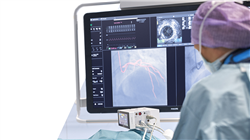University certificate
The world's largest faculty of medicine”
Introduction to the Program
With this Postgraduate diploma, based on Relearning, you will combine different advanced imaging techniques to obtain comprehensive diagnoses that will allow you to perform the most appropriate interventions”

In the field of medical diagnostics, Angiography and Vascular Diagnostics occupy a preeminent place due to their ability to provide detailed visualizations of blood vessels and identify anomalies with high precision. Thanks to new technologies driven by the advent of Industry 4.0, medical staff have state-of-the-art tools to assess the clinical condition of their patients. For example, CT scans are useful for diagnosing a wide variety of conditions (such as traumatic injuries, infectious diseases, tumors, and even bone or vascular disorders). In order for physicians to get the most out of these instruments, they need to acquire practical skills for their optimal use.
In this context, TECH has developed a revolutionary Postgraduate diploma in Angiography and Vascular Diagnostics. Conceived by references in this field, the academic itinerary will deepen the use of the latest generation machinery for vascular intervention (among which are the Access Needles, Dilators or Catheters). In line with this, the syllabus will provide graduates with strategies to prevent complications after procedures involving puncture. In addition, the didactic materials will delve into the most modern Non Invasive Vascular Imaging techniques (such as Magnetic Resonance Imaging and Doppler Ultrasound). In this regard, the program will analyze the keys to perform Balloon Angioplasty procedures safely and effectively. Thanks to this, physicians will skillfully employ Angiography not only as a diagnostic tool, but also as a guide in therapeutic interventions.
The program is made more dynamic thanks to the multimedia pills and the wide variety of teaching resources offered by TECH (such as specialized readings, interactive summaries or case studies). In addition, TECH's Relearning methodology will allow practitioners to obtain a much more effective update in a shorter period of time. Therefore, their learning process will be completely natural and progressive, so they will not have to invest long hours of study.
Study from the comfort of your home and update your knowledge online with TECH Global University, the biggest online university in the world”
This Postgraduate diploma in Angiography and Vascular Diagnosis contains the most complete and up-to-date scientific program on the market. The most important features include:
- The development of case studies presented by experts in Angiology and Vascular Surgery
- The graphic, schematic and practical contents with which it is conceived gather scientific and practical information on those disciplines that are essential for professional practice
- Practical exercises where the self-assessment process can be carried out to improve learning
- Its special emphasis on innovative methodologies
- Theoretical lessons, questions to the expert, debate forums on controversial topics, and individual reflection assignments
- Content that is accessible from any fixed or portable device with an Internet connection
You will delve into the use of the most sophisticated embolic protection devices and prevent your patients from suffering serious complications such as strokes and heart attacks”
The program’s teaching staff includes professionals from the sector who contribute their work experience to this specializing program, as well as renowned specialists from leading societies and prestigious universities.
The multimedia content, developed with the latest educational technology, will provide the professional with situated and contextual learning, i.e., a simulated environment that will provide immersive education programmed to learn in real situations.
This program is designed around Problem-Based Learning, whereby the professional must try to solve the different professional practice situations that arise during the course. For this purpose, students will be assisted by an innovative interactive video system created by renowned and experienced experts.
Do you want to incorporate innovative Drug Delivery Monitoring techniques into your clinical practice? Achieve it with this 6-month program"

You will effectively manage Stents devices to treat cardiovascular diseases such as Angina Pectoris and restore blood flow in the arteries"
Why study at TECH?
TECH is the world’s largest online university. With an impressive catalog of more than 14,000 university programs available in 11 languages, it is positioned as a leader in employability, with a 99% job placement rate. In addition, it relies on an enormous faculty of more than 6,000 professors of the highest international renown.

Study at the world's largest online university and guarantee your professional success. The future starts at TECH”
The world’s best online university according to FORBES
The prestigious Forbes magazine, specialized in business and finance, has highlighted TECH as “the world's best online university” This is what they have recently stated in an article in their digital edition in which they echo the success story of this institution, “thanks to the academic offer it provides, the selection of its teaching staff, and an innovative learning method aimed at educating the professionals of the future”
A revolutionary study method, a cutting-edge faculty and a practical focus: the key to TECH's success.
The most complete study plans on the university scene
TECH offers the most complete study plans on the university scene, with syllabuses that cover fundamental concepts and, at the same time, the main scientific advances in their specific scientific areas. In addition, these programs are continuously being updated to guarantee students the academic vanguard and the most in-demand professional skills. In this way, the university's qualifications provide its graduates with a significant advantage to propel their careers to success.
TECH offers the most comprehensive and intensive study plans on the current university scene.
A world-class teaching staff
TECH's teaching staff is made up of more than 6,000 professors with the highest international recognition. Professors, researchers and top executives of multinational companies, including Isaiah Covington, performance coach of the Boston Celtics; Magda Romanska, principal investigator at Harvard MetaLAB; Ignacio Wistumba, chairman of the department of translational molecular pathology at MD Anderson Cancer Center; and D.W. Pine, creative director of TIME magazine, among others.
Internationally renowned experts, specialized in different branches of Health, Technology, Communication and Business, form part of the TECH faculty.
A unique learning method
TECH is the first university to use Relearning in all its programs. It is the best online learning methodology, accredited with international teaching quality certifications, provided by prestigious educational agencies. In addition, this disruptive educational model is complemented with the “Case Method”, thereby setting up a unique online teaching strategy. Innovative teaching resources are also implemented, including detailed videos, infographics and interactive summaries.
TECH combines Relearning and the Case Method in all its university programs to guarantee excellent theoretical and practical learning, studying whenever and wherever you want.
The world's largest online university
TECH is the world’s largest online university. We are the largest educational institution, with the best and widest online educational catalog, one hundred percent online and covering the vast majority of areas of knowledge. We offer a large selection of our own degrees and accredited online undergraduate and postgraduate degrees. In total, more than 14,000 university degrees, in eleven different languages, make us the largest educational largest in the world.
TECH has the world's most extensive catalog of academic and official programs, available in more than 11 languages.
Google Premier Partner
The American technology giant has awarded TECH the Google Google Premier Partner badge. This award, which is only available to 3% of the world's companies, highlights the efficient, flexible and tailored experience that this university provides to students. The recognition as a Google Premier Partner not only accredits the maximum rigor, performance and investment in TECH's digital infrastructures, but also places this university as one of the world's leading technology companies.
Google has positioned TECH in the top 3% of the world's most important technology companies by awarding it its Google Premier Partner badge.
The official online university of the NBA
TECH is the official online university of the NBA. Thanks to our agreement with the biggest league in basketball, we offer our students exclusive university programs, as well as a wide variety of educational resources focused on the business of the league and other areas of the sports industry. Each program is made up of a uniquely designed syllabus and features exceptional guest hosts: professionals with a distinguished sports background who will offer their expertise on the most relevant topics.
TECH has been selected by the NBA, the world's top basketball league, as its official online university.
The top-rated university by its students
Students have positioned TECH as the world's top-rated university on the main review websites, with a highest rating of 4.9 out of 5, obtained from more than 1,000 reviews. These results consolidate TECH as the benchmark university institution at an international level, reflecting the excellence and positive impact of its educational model.” reflecting the excellence and positive impact of its educational model.”
TECH is the world’s top-rated university by its students.
Leaders in employability
TECH has managed to become the leading university in employability. 99% of its students obtain jobs in the academic field they have studied, within one year of completing any of the university's programs. A similar number achieve immediate career enhancement. All this thanks to a study methodology that bases its effectiveness on the acquisition of practical skills, which are absolutely necessary for professional development.
99% of TECH graduates find a job within a year of completing their studies.
Postgraduate Diploma in Angiography and Vascular Diagnosis
Would you like to acquire specialized skills in the field of angiography and vascular imaging? This Postgraduate Diploma created by TECH Global University is the ideal option for you. This specialized program, taught in 100% online mode, provides you with advanced specialization in medical imaging techniques for the study of blood vessels and the diagnosis of vascular diseases. Here, you will be immersed in the principles and fundamentals of angiography, interpretation of angiographic images, vascular anatomy, circulatory physiology and contrast injection techniques. Also, topics related to the diagnosis of vascular diseases such as peripheral arterial disease, deep vein thrombosis, aneurysms and cerebral vascular pathology will be addressed. One of the most outstanding advantages of this online program is the flexibility it offers you to study according to your time availability and from any location with Internet access. Through an interactive platform, you will have access to didactic materials, virtual content, analysis of clinical cases, discussion forums and practical activities, all guided by experts in vascular imaging.
Get a postgraduate diploma in Angiography and Vascular Diagnosis
This program is a proposal of voluminous but dynamic content devised by TECH as a way to update your skills in the face of the new demands of the labor market. Within the respective specialization, we offer you both online classes that you can manage under your own time availability, as well as a diverse interactive agenda that encompasses the analysis of angiographic images, allowing you to develop practical skills and improve your ability to interpret and diagnose vascular disorders accurately. Upon completion of the Postgraduate Diploma, you will be prepared to apply your knowledge in clinical and research settings, as well as to meet the diagnostic and therapeutic challenges related to vascular diseases. This specialized training will provide you with a competitive advantage in the field of medical imaging, enabling you to provide accurate diagnoses and improve the quality of care for patients with vascular disorders. What are you waiting for to enroll? By doing so, you will be part of the world's largest digital academic community. We look forward to seeing you!







